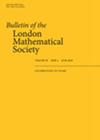On the relation between pseudocharacters and Chenevier's determinants
IF 0.8
3区 数学
Q2 MATHEMATICS
引用次数: 0
Abstract
Consider a commutative unital ring and a unital -algebra . Let be a positive integer. Chenevier proved that when is invertible in , the map associating to a determinant its trace is a bijection between -valued -dimensional determinants of and -valued -dimensional pseudocharacters of . In this paper, we show that assuming is invertible in is sufficient. This assumption is already made in the definition of a -dimensional pseudocharacter. Our proof involves establishing a product formula for pseudocharacters, which might be of independent interest.
论伪字符与切内维埃行列式之间的关系
考虑一个交换一元环a $ a $和一个一元a $ a $ -代数R$ R$。设d$ d$为正整数。Chenevier证明了当(2d) !美元(2 d) !$在A$中是可逆的,与行列式相关联的映射,它的迹线是a $ a $值的d$ d$维的R$ R$行列式和a $ a $值的d$ d$维伪字符之间的双射R$ R$。在本文中,我们证明了假设d !$ d !$在A中可逆,A$是充分的。这个假设已经在d$ d$维伪字符的定义中做出了。我们的证明包括建立伪字符的乘积公式,这可能是独立的兴趣。
本文章由计算机程序翻译,如有差异,请以英文原文为准。
求助全文
约1分钟内获得全文
求助全文
来源期刊
CiteScore
1.90
自引率
0.00%
发文量
198
审稿时长
4-8 weeks
期刊介绍:
Published by Oxford University Press prior to January 2017: http://blms.oxfordjournals.org/

 求助内容:
求助内容: 应助结果提醒方式:
应助结果提醒方式:


